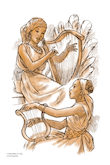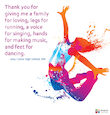Praying the Psalms
About this article
Praying with our students is a valuable and very important activity. This strategy takes 4 or 5 minutes of each class period to pray a psalm, using a book that paraphrases the psalms into language that is "teen-friendly." This idea is not only easy to incorporate in the classroom, but has been very successful with students as prayer and scripture review!
Remember the television show from the late 80's called "Doogie Howser, M.D.?" At the end of every show, Doogie would sit down at his computer and write a 2 or 3 sentence "blurb" that perfectly summed up his day and the theme of the show that week. I've always been an avid journal keeper but I tend to write in spurts as opposed to the disciplined every day journal writer. I have found that many of my students are similar in that regard.
At the beginning of class, we read a psalm aloud. I then encourage students to find a line, word, thought in the prayer that speaks to them that day and write a couple sentences about how that ties in to their life experiences. I then turn on my favorite Celtic instrumental music and play it quietly for a couple minutes while we write in our books. I do this along with my students.
I then turn off the music and ask if anyone would like to share. Some days no one does and then I'll share some of my thoughts or discuss some background for that particular psalm-- what type it is, when it was written, why, liturgical uses, etc. But more than not, students have hands raised, ready to share with their peers. The students connect immediately to many of the themes found in the psalms and the sharing that begins my class each day is authentic and awesome.
I believe students will treasure their psalm journals at the end of the year when they can look back on what they have written and follow their growth and journey in faith. I am constantly amazed at how students can capture their thoughts and questions, feelings and struggles in a "Doogie" journal entry. I also believe the 5-6 minutes I spend doing this with my students is invaluable!
Acknowledgments
Published December 28, 1999.





